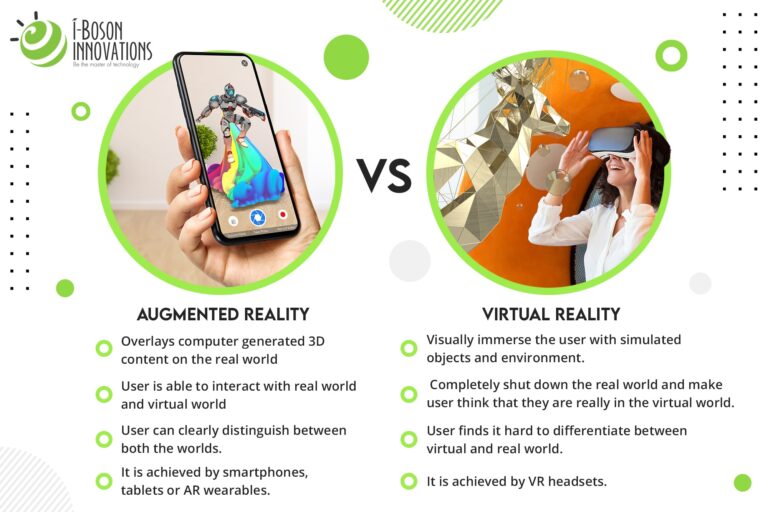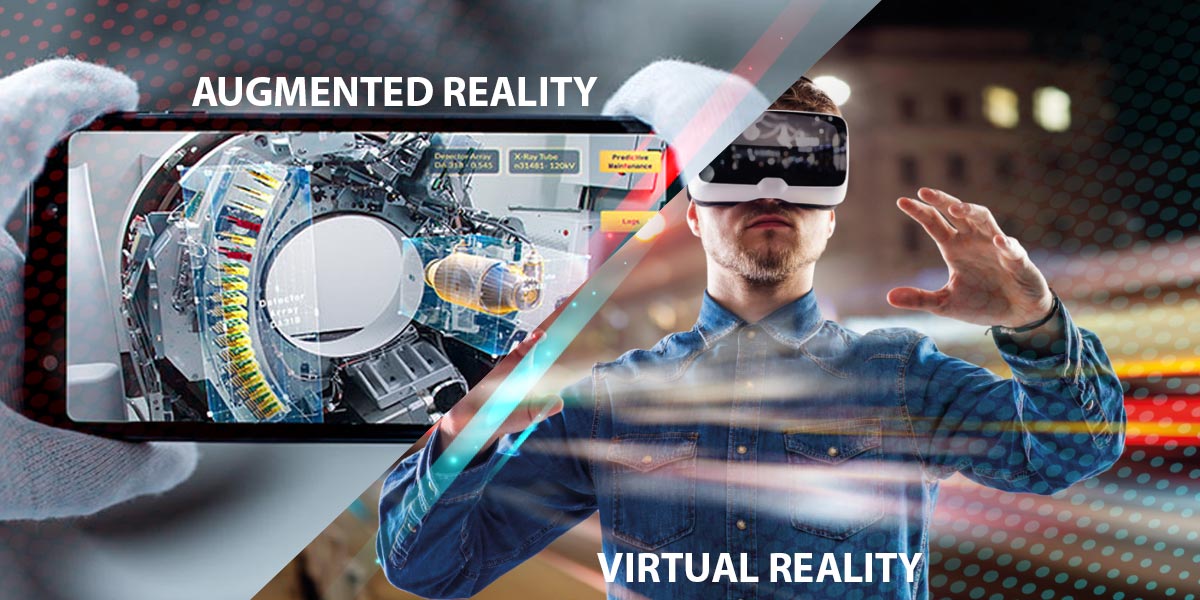In the realm of technology, augmented reality and virtual reality stand out as two prominent innovations that have revolutionized various industries. This comparison delves into the intricacies of AR and VR, shedding light on their key differences and real-world applications.
Brace yourself for a journey through the immersive world of augmented reality vs virtual reality.
Introduction

Augmented reality (AR) and virtual reality (VR) are two distinct technologies that have gained popularity in recent years. AR involves overlaying digital information onto the physical world, while VR creates a completely immersive digital environment.
The key difference between AR and VR lies in the level of immersion they provide. AR enhances the real world by adding digital elements, whereas VR transports users to a completely virtual environment, cutting them off from the physical world.
Examples of Use in Various Industries
- AR: In the healthcare industry, AR is used for surgical planning and training, allowing surgeons to visualize complex procedures before operating. In retail, AR is used for virtual try-on experiences, allowing customers to see how products look before purchasing.
- VR: In the gaming industry, VR provides immersive gaming experiences where players can feel like they are inside the game world. In the architecture and real estate industry, VR is used for virtual property tours, allowing clients to explore properties remotely.
Technology Behind AR and VR
Augmented Reality (AR) relies on a combination of technologies to superimpose digital information such as images, videos, or 3D models onto the user's view of the real world. This is typically achieved through the use of cameras, sensors, and software algorithms that can detect and track the user's surroundings in real-time.Virtual Reality (VR), on the other hand, creates a completely immersive digital environment that simulates a physical presence in a different world.
This is made possible through the use of headsets or goggles that block out the real world and replace it with a computer-generated environment. VR systems also include motion tracking sensors to detect the user's movements and adjust the virtual environment accordingly.
Hardware Requirements for AR and VR
- Augmented Reality:
- Smartphone or tablet with AR capabilities
- AR glasses or headsets
- Cameras and sensors for real-time tracking
- Strong processing power for rendering digital overlays
- Virtual Reality:
- VR headset or goggles
- Controllers for interaction with the virtual environment
- High-resolution displays for an immersive experience
- Powerful graphics processing units (GPUs) for rendering complex virtual worlds
Applications in Different Fields

Augmented reality (AR) and virtual reality (VR) have found numerous applications in various fields, revolutionizing the way we learn, practice medicine, and shop. Let's delve into how AR and VR are transforming education, healthcare, and the retail industry.
Augmented Reality in Education
AR technology has significantly enhanced the learning experience in education by providing interactive and immersive content. Students can visualize complex concepts in 3D, making subjects like anatomy, astronomy, and geography more engaging. For example, AR apps allow students to explore the human body or planets in our solar system by overlaying digital information onto the physical world.
This hands-on approach fosters better understanding and retention of knowledge.
Virtual Reality in Healthcare
Virtual reality has revolutionized the healthcare industry by offering innovative solutions for training, therapy, and patient care. Medical professionals can practice surgeries in a simulated environment, improving their skills and reducing the risk during actual procedures. VR is also used for treating phobias, PTSD, and chronic pain by exposing patients to controlled virtual scenarios.
Moreover, VR headsets are utilized for pain management during medical procedures, reducing the need for anesthesia and opioids.
Augmented Reality in Retail
AR is reshaping the retail industry by providing personalized and interactive shopping experiences to consumers. Retailers can offer virtual try-on options for clothing, accessories, and cosmetics, allowing customers to visualize products before making a purchase. AR technology also enables in-store navigation, product information overlays, and interactive advertisements, enhancing customer engagement and driving sales.
By blending the physical and digital worlds, AR transforms traditional retail spaces into immersive and futuristic environments.
Advantages and Disadvantages

When it comes to using augmented reality (AR) and virtual reality (VR), there are various advantages and disadvantages to consider. Let's delve into the benefits of AR in training simulations, the drawbacks of VR related to motion sickness, and the ways in which both technologies enhance customer experiences.
Advantages of Using Augmented Reality in Training Simulations
- Enhanced Learning Experience: AR allows trainees to interact with virtual objects in the real world, making the learning process more engaging and effective.
- Real-time Feedback: Trainees can receive immediate feedback on their performance, helping them improve and learn at a faster pace.
- Cost-effective: AR training simulations eliminate the need for physical equipment or resources, saving costs associated with traditional training methods.
- Safe Environment: AR simulations provide a safe space for trainees to practice complex tasks without any risk of injury.
Disadvantages of Virtual Reality in Terms of Motion Sickness
- Motion Sickness: Some users may experience motion sickness or discomfort when using VR headsets, especially during extended periods of use.
- Eye Strain: Prolonged exposure to VR environments can cause eye strain and fatigue, leading to potential health issues.
- Restricted Mobility: VR users are often required to stay in one place while wearing the headset, limiting their physical movements.
Comparison of Benefits in Enhancing Customer Experiences
- AR for Personalized Experiences: AR can be used to provide personalized product recommendations and interactive shopping experiences, enhancing customer engagement.
- VR for Immersive Experiences: VR allows customers to virtually experience products or services before making a purchase, leading to higher customer satisfaction and reduced return rates.
- Combining AR and VR: By combining AR and VR technologies, businesses can offer a seamless and immersive customer experience that blends the physical and digital worlds.
Future Trends
Augmented Reality and Virtual Reality are rapidly evolving technologies with immense potential to shape the future in various aspects. Let's delve into the predicted trends for both AR and VR.
Augmented Reality in Gaming
Augmented Reality is set to revolutionize the gaming industry by providing immersive and interactive experiences. With the advancement of AR technology, we can expect to see:
- Integration with wearable devices for a seamless gaming experience.
- Enhanced graphics and realistic simulations for a more engaging gameplay.
- Multiplayer AR games that blend virtual elements with real-world environments.
- Increased adoption of AR in mobile gaming applications, offering unique and innovative gameplay features.
Virtual Reality in Remote Work
Virtual Reality has the potential to transform remote work by creating virtual office spaces and enhancing collaboration among teams. The future trends for VR in remote work include:
- Virtual meeting rooms and workspaces designed for remote teams to interact and collaborate in real-time.
- Simulation of physical office environments to improve productivity and communication among team members.
- Training programs conducted in VR to upskill employees and enhance their professional development remotely.
- Integration of VR technology with project management tools for effective task management and team coordination.
Impact of AR and VR on Social Interactions
AR and VR are poised to revolutionize social interactions by offering unique ways to connect with others and experience virtual environments. The potential impact of AR and VR on social interactions includes:
- Virtual social platforms where users can interact, communicate, and engage with each other in immersive virtual spaces.
- AR filters and effects for video calls and social media platforms to enhance user experience and add fun elements to communication.
- Virtual events and gatherings in VR for socializing and networking with people from around the world without physical boundaries.
- Integration of AR elements in social apps for location-based services, creating shared experiences and memories among users.
Epilogue
As we conclude this exploration of augmented reality and virtual reality, it becomes evident that these technologies continue to shape the way we interact with the digital realm. From education to healthcare, retail, and beyond, the future holds endless possibilities for AR and VR.
Stay tuned for the next chapter in the evolution of immersive experiences.
Essential Questionnaire
What are the key differences between augmented reality and virtual reality?
Augmented reality overlays digital content onto the real world, while virtual reality immerses users in a completely virtual environment.
How is augmented reality used in education?
AR is used in education to create interactive learning experiences, allowing students to visualize complex concepts in a hands-on way.
What are the advantages of using augmented reality in training simulations?
AR in training simulations provides a realistic and interactive environment for learners to practice skills in a safe and controlled setting.



